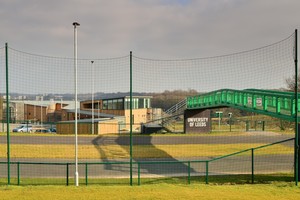Leeds trial using nature to reduce flood risk gets on its marks
A pilot by the Environment Agency and University of Leeds at the Brownlee Triathlon Centre looks at using natural flood management to reduce flood risk.

The Brownlee Triathalon Centre at University of Leeds
Image credit: provided by University of Leeds
A trial is being launched by the Environment Agency and University of Leeds at the Brownlee Triathlon Centre to look at how nature can be used to help reduce flood risk.
This will be the first urban pilot site set up as part of the Leeds Flood Alleviation Scheme’s natural flood management (NFM) project.
It is being launched at the centre, owned by University of Leeds, to inspire students and the Leeds community to test how natural solutions such as creating wetlands can be used to help reduce the risk of flooding along the River Aire and in Leeds.
The site will be used to showcase many innovative ways to deliver NFM which will be used for academic research and help to develop practical ways to monitor different techniques and gather evidence on their success. When work on this urban pilot site begins towards the end of the year, it will be carried out in line with the latest government guidelines on social distancing.
Five pilot sites have been set up as part of the Leeds Flood Alleviation Scheme using techniques such as woodland creation, wetland scrapes and leaky barriers.
Holly Radcliffe Leeds NFM project manager from the Environment Agency, said:
We are very grateful to University of Leeds for working with us to develop a pilot site at the Brownlee Triathlon Centre to trial and test natural flood management.
The Triathlon Centre is a real asset for students and the local community, and are excited to work further with them to develop suitable designs for the site. “We hope that visitors will also be able to learn about how effective NFM techniques can be.
As the country faces a national and global climate emergency, restoring our natural environment is an important component to help reach net zero emissions in the future.
Natural Flood Management offers potential for climate mitigation, for example, creating wetlands, restoring our uplands and planting trees can help to capture tonnes of carbon from the atmosphere.
James Wright, from grounds and gardens team at University of Leeds, said:
We are delighted to be working with the Environment Agency on a natural flood management project at the Brownlee Centre.
This is a great opportunity to showcase the huge benefits of working with natural process to Leeds Community and academic partners across the university.
Councillor Judith Blake, Leader of Leeds City Council said:
This first urban pilot of the natural flood management programme is an exciting addition to the range of natural solutions we are exploring across the catchment to reduce flood risk. This approach can bring many different benefits so this is a promising opportunity to both enhance the local environment whilst building our resilience to climate change.
The site earmarked for the project is at Bodington Playing Fields to the north east of Leeds city centre.
The Brownlee Triathalon site earmarked for the project is to the north east of Leeds city centre.
Proposals for the site currently include:- • Woodland creation – planting almost 4,000 trees and hedges at various locations across the site • Measures to improve the management of the flow of surface water including grass covered earth bund -embankments which act as flood barriers to store water and pocket wetland – to be formed from series of wetland scrapes (shallow ponds) to control storm-water • An interactive information board to educate visitors about the benefits of each type of NFM and monitoring taking place on the site • A teaching area for groups, for example a two-tier grass covered amphitheatre, formed as an earth bund, an NFM measure and benches made from wood from various tree species on site • Demonstration areas featuring how to build your own leaky dam, the life-cycle of a tree and a sand pit where you can re-meander a straightened water channel • A discovery walk featuring sculptures, nature base art, activities, wildlife spotting, edible hedges and a sensory trail • Creation of a virtual tour of the site using 360 degree photographs
This pilot site will be part of the flagship Natural Flood Management (NFM) programme which forms part of the second phase of the Leeds Flood Alleviation Scheme alongside traditional engineering.
The development of the scheme is being led by Leeds City Council, working alongside the Environment Agency. This phase got underway this year and aims to invest £112.1 million in flood prevention measures for areas upstream of Leeds city centre, to better protect 1,048 homes and 474 businesses.
The NFM element is transformational in scale working with nature to reduce the risk of flooding across the catchment from the source of the River Aire, at Malham, through to Leeds City Centre. The programme will not only reduce flow of water from upstream so the landscape can hold more water in times of flood but also restore and create new habitat, increase biodiversity resilience and improve water quality. As well as tree and hedge planting, it includes re-channelling rivers to their natural courses, soil aeration, wetland creation and moorland restoration all of which have lots of benefits for people and wildlife.
This will contribute to delivering the Government’s 25 Year Environment Plan and realising the vision of the Northern Forest in the Aire catchment.
For more information about the LeedsFAS visit
If you have land and would like to know more about how you could be involved in an NFM project, please get in touch with the project team and provide your contact details and the will get back to you. Email:[email protected]